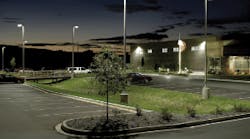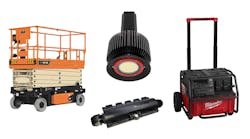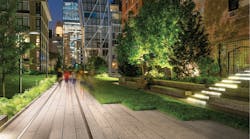Outdoor and landscape lighting solutions have evolved over the past decade, becoming more complex as they gain greater efficiency features to satisfy the latest codes and mandates. New light sources, more reliable and efficient ballasts that offer multi-voltage features, flexible light distribution systems, versatile control capabilities, and “networked” street lighting are just some of the latest advancements worth noting.
While the selection of outdoor area lighting equipment encompasses a broad range of applications and demands, the light source should be the first consideration. Common lamp types typically considered include: metal-halide (MH), high-pressure sodium (HPS), light emitting diode (LED), induction fluorescent, and light-emitting plasma (LEP). Along with energy efficiency and color performance of the light source, the light-generating technology is also a major factor when choosing a luminaire.
Mature Light Sources
The high-intensity discharge (HID) sources — MH and HPS lamps — are the most mature technologies. As such, they are the least expensive in this highly competitive market segment. Although HPS offers a long operating life and remains a viable choice, it has a restricted color rendering capability. Therefore, most of the interest focuses on the MH source.
With the development of even smaller arc tubes using ceramic material, MH lamps offer higher efficiency, smaller size, and improved color, as well as other performance features. Considered a cross between MH and HPS, ceramic metal-halide (CMH) lamps provide an energy-efficient, high lumen, point source with a high R9 factor, meaning they have the ability to render saturated red colors.
A CMH source served by an electronic ballast is an excellent choice for a variety of exterior applications. Some electronic ballasts for CMH lamps are also dimmable. In fact, some can quickly dim to 50% and back up to full light output, making them suitable for use with high/low occupancy sensors. Another breakthrough in high-wattage electronic HID ballasts is the adoption of a low-frequency square wave shape already popular in low-wattage CMH systems. The low-frequency square wave reduces lamp wear while boosting performance.
One advancement recently introduced into the market increases the operating hours between lamp replacements to 60,000 hr. The exterior luminaire contains two CMH lamps served by a single one-lamp ballast, which operates one lamp at a time. When the first lamp fails, the second one is energized, thus extending the maintenance interval.
Two recently developed systems using very compact MH lamps offer good optical control in new and retrofit luminaires. The first system is available in 45W, 60W, 90W, and 140W sizes. Mean lumen maintenance is approximately 85%, and end-of-life maintenance is also impressive. The second system is available in 210W and 315W ratings, and is designed to be a one-for-one replacement for existing 250W to 400W HPS and standard MH lamps. Lumen maintenance is 80% at 20,000 hr, and the color temperature options include 3,000K and 4,200K with a CRI greater than 90.
The entire family of HID lamps is increasingly becoming controllable — offering dimming capability using either step or continuous dimming systems. Magnetic ballasts can be step-dimmed, reducing the lumen output from “full” down to certain percentage of rated lamp power, usually 50%. For applications requiring more flexibility, continuous dimming can be performed using panel-level line voltage dimming units or dimmable electronic ballasts.
The National Electrical Manufacturers Association (NEMA) recommends that HID lamps not be dimmed below the recommended minimum stated in manufacturer’s literature, because lamp life can be reduced — potentially voiding lamp warranties — while adversely affecting efficacy, color, and lumen maintenance.
New Light Sources
Recent advances in materials, packaging, and optical design for the LED light source make them prime choices in the street/parking lighting market. Although currently much more expensive than HID lamps, the LED source offers greater versatility with higher lumens per watt efficacy, longer life, and minimum maintenance costs. With attention to visual acuity becoming increasingly important, the LED source is now offered in a number of color temperatures, ranging from 2,700K to 6,000K.
Additionally, the LED source allows greater controls integration — everything from motion sensors and photocells to luminaires that self-diagnose and report energy savings to electric utility companies for rebates. Because LED roadway luminaires can be continuously dimmed while retaining their efficacy, the footcandle levels on the road surface can be infinitely adjusted to suit weather/atmospheric conditions; for example, lowering the light level on a rain slick highway or during a fog condition to give drivers improved visibility.
According to the 2011 U.S. Department of Energy (DOE) report, “Energy Saving Estimates of Light Emitting Diodes in Niche Lighting Applications,” more than 53 million roadway lighting units (street and highway) across the United States could benefit from an upgrade. In addition, the DOE is actively promoting LED lighting by posting drafts of street lighting specification documents for street lighting buyers who are focused on solid-state lighting (SSL) projects.
Several other recently developed light sources are also noteworthy. The long life of the induction fluorescent lamp, which ranges from 65,000 hr to 100,000 hr, favors this source when optical control is not critical. Offering performance of 60 lm/W to 70 lm/W, induction lamps are available in a variety of wattages to replace HID sources.
Still another technology, LEP is a potential source for high-illuminance applications — specifically as a replacement for 400W and higher-wattage MH and HPS systems. This technology offers the same lumens while using about 40% less electric power. Furthermore, the LEP source has a projected 50,000-hr life at 70% lumen maintenance, and the lamps are available with a continuous color spectrum and a CRI of 75, 80, or 95.
An LEP system consists of a power supply, a driver (which is essentially a solid-state RF amplifier), and an emitter (a small glass tube containing gases and halides that is embedded in a ceramic puck). Of possible importance in outdoor locations, LEP offers excellent mesotopic and scotopic lumens, in which nighttime visibility is critical. Applications include high mast systems (where compactness of the fixture reduces wind load) and where optical control is necessary.
Energy Codes and Visual Needs
Commercial building energy codes continue to impose restrictions on outdoor lighting. The State of California’s Title 24 energy code and the ASHRAE/IES 90.1 2010 energy standard go even further by requiring outdoor and parking garage lighting to be capable of bi-level switching. In addition, California Title 20 product regulations require 150W to 500W MH luminaires to achieve a certain level of ballast (or fixture efficiency) or employ automatic energy-saving lighting control.
Title 24 introduced the idea of lighting zones and energy use (power densities of the exterior lighting) in each of four zones. Zone 1 covers areas such as parks and wildlife preserves. Zone 2 covers rural areas, while urban areas fall into Zone 3. Zone 4 refers to special use facilities, such as a sports complex, which is determined by the local AHJ. The ideal is to state how much energy each zone should use.
Outdoor light pollution is addressed by The International Dark-Sky Association (IDA) and the Illuminating Engineering Society of North America (IESNA) in a standard municipal ordinance regulating outdoor lighting. The standard was finalized in June 2011. Called the Model Lighting Ordinance (MLO), this document expands the lighting zone concept of Title 24, separating nonresidential and residential lighting and offering two compliance paths: prescriptive or performance. It also includes lighting controls.
Specifically, the MLO is concerned with wasteful upward light from outdoor sources that is scattered in the atmosphere and reflected back to Earth as glow (light going skyward that can obscure the nighttime view of stars), light trespass (light shining onto neighboring property), and source glare (excessive brightness that impairs or disables vision). The MLO document creates five different zones, from LS0 (zero lighting) to LS4 (high ambient lighting), and uses a simple prescriptive method.
To assist in categorizing luminaires, the MLO created a “BUG” rating system. This term refers to the Luminaire Classification System referenced in the IESNA TM-15-11 standard for describing a luminaire based on three prescriptive metrics: backlight (B), uplight (U) and glare (G). In each zone, based on degrees of light emitted and in what quantity, the luminaire receives a rating, with the lowest/worst rating being 5 and the highest/best being 0. Intended to replace the older cutoff classification, this rating system should prove more useful, and many of today’s manufacturers publish the BUG ratings of their exterior area roadway and parking lot luminaires.
Electrical contractors should become familiar with the MLO as well as other local laws and ordinances, and should also understand why these laws and ordinances are being enforced. Only then will they be able to help design and install more effective and sustainable outdoor lighting systems.
Sidebar 1: Network-Based Control
Several lighting equipment manufacturers offer a network-based automated asset management system for roadway and street lighting that is accessed by a 2-way communications system. The receptacle/photo detector device on the top side of the luminaire, which automatically turns on the lights at dusk and off at dawn, is replaced with a device that monitors and controls the luminaire’s performance — and is also a network node in a wireless network. Information from the device is sent via a wireless RF system to a local access point (AP). The AP aggregates information from hundreds of nodes and then communicates the data by means of either a wireless or wired network, back to a secure server at a network operations center (NOC).
Sidebar 2: Tips for Outdoor Lighting Design and Specification
- Obtain photometric information of the intended luminaire.
- If possible, obtain an actual luminaire and then make a bench-top examination of the optical components, the housing, the finish, and the maintainability of the components.
- If LED is the intended light source, find out the temperature range of the source; is an IES LM-80 test report available; what is the expected lifetime of the specific luminaire and how is it calculated? Is an IES LM-79 test report available from an independent third-party laboratory?
- What are the delivered lumens and lumen per watt of the luminaire?
-
What is the power factor of the luminaire, and what is the power consumption in
the “off” state?




